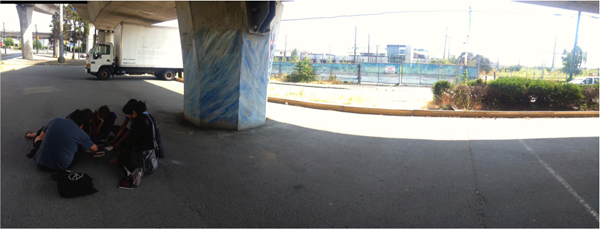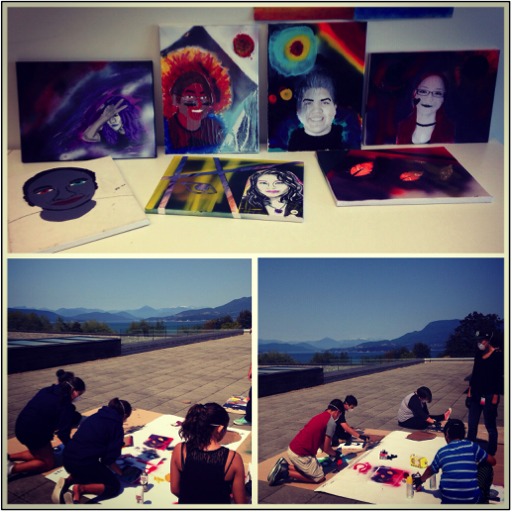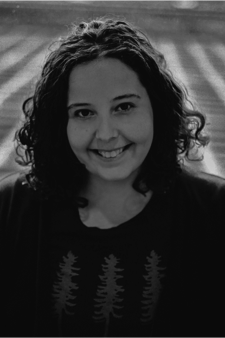By Molly Billows
The Native Youth Program (NYP), currently in its 36th year, is the longest running Aboriginal public program at the University of British Columbia Museum of Anthropology (MOA). Each summer the program brings together six urban Aboriginal youths from the Greater Vancouver area to develop and lead public tours in the museum.
This year the youths are giving tours of c̓əsnaʔəm: the city before the city, an exhibition which celebrates one of Musqueam’s ancient village sites in what is now Vancouver, while centering the voices of Musqueam community members and highlighting the Musqueam language, oral history, and the community’s continuous connection to their territory.
c̓əsna?əm: the city before the city is a three-site exhibition taking place at MOA, the Musqueam Cultural Education Resource Centre & Gallery, and the Museum of Vancouver (MOV). With this in mind, we thought it was important for the youths who would be leading tours at MOA to gain a sense of all three exhibitions. We also decided to use this summer to investigate our own relationships to “place” as a group of Indigenous peoples who come from nations across Turtle Island, working together on Musqueam territory, sharing our connections to Vancouver and this exhibition with the public.
During the first week of the program, as part of this self-exploration, we went down to the ancient village site of c̓əsnaʔəm, an archaeological site associated with the Musqueam people, known to archeologists as the Marpole midden. We sat together below a busy overpass, listening and witnessing what this place, this ancient village, looks like now: largely unrecognizable, mostly covered with concrete, a few empty lots fenced off, with the Musqueam logo drawn in chalk on one of the pillars—a visible reminder of the 200-day vigil that took place here in 2012 and the commitment of the Musqueam peoples and their allies in protecting this site.

Sitting there on the concrete, the youth did a free-writing exercise and choose their favorite lines and descriptions from their writing in order to create a collective poem. They then wrote their poem with chalk on another one of the pillars:
I can hear the screech of cars,
the smell of cigarettes of tar,
the sins of pollution, urbanization
of the peoples separated from their nations,
cars driving by, birds in the sky,
I see newspaper blowing in the wind.
I see baby feathers,
the screech of brakes is drowning
out a call for a bird’s mate,
I can hear the voices of the earth
over the roar of a truck,
old ancestors, hear what our home has become,
see the loss of all that we love,
the sounds of the city slowly fade to nothing,
the only sense I have is of the breeze
grabbing the whisps of my hair,
as if beckoning me across the busy street,
it’s as if my soul remembers.
This society thinks it is the original city,
but you are the city before the city.
This collective poetry workshop was only one of many ways that we explored the idea of “self” in relation to place. Throughout the seven-week program, the youths also participated in workshops with Indigenous artists, exploring these themes and others through an array of mediums and arts practices, including drawing comic books with Walter Scott (Mohawk from Kahnawake), pastel drawing with Cody Lecoy (Okanagan and Esquimalt), and aerosol arts with Larissa Healy (Ojibwe).

Mixed media (photography, painting, and aerosol art) with Jeneen Frie Njootli (Vuntut Gwithcin First Nation).
The youths also participated in a four-day dance intensive (exploring traditional and contemporary movement) with the Dancers of Damelahamid, and attended artist talks from Lawrence Paul Yuxweluptun, Raymond Boisjoly, and Mique’l Dangeli.
The fullness and breadth of this program is intended to engage the youths with a variety of art mediums, to foster relationships within community, and to build relationships with contemporary Indigenous art practices that they can carry into the future. I think it is these relationships that will have the most lasting impact for the youth moving forward. As one participant, Maya (Mohawk and Métis) noted, “We met a plethora of successful Indigenous people whom have motivated me to accomplish something significant in my life.” Through meeting these inspiring Indigenous artists and guests, and by participating in workshops, the youth were also able to explore their own interests and consider how they can contribute their own gifts and skills to their communities. As another participant, Tyson (Musqueam, Scowlitz, Lacunar, Mohawk, Cayuga, and Ojibway) noted, “I applied to the NYP because I wanted to represent my community, parents, and grandparents in a respectful way. This job helped me reach my personal goal, and that’s to let any aboriginal kids know that they are important to their community.”
 Although this year’s Native Youth Program comes to an end on August 21, 2015, c̓əsnaʔəm: the city before the city continues at MOA until January 2016.
Although this year’s Native Youth Program comes to an end on August 21, 2015, c̓əsnaʔəm: the city before the city continues at MOA until January 2016.
Molly Billows is Northern Coast Salish from the Homalco Nation. She was raised in Victoria BC, and has been living in Vancouver for the past four years. She graduated from UBC with a bachelor degree in Indigenous peoples and Land Health, through the Faculty of Land and Food Systems. She is currently working as the Program Assistant with the Native Youth Program at the Museum of Anthropology.








Add new comment